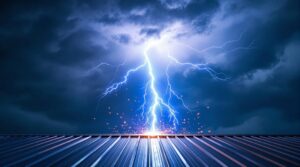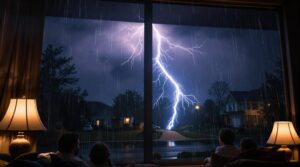Individuals can be struck by lightning while showering as lightning travels through metal pipes and water, following the path of least resistance. This increases the risk of injury for those in contact with plumbing fixtures during a storm. Water conducts electricity, making contact with it during a storm particularly hazardous. To minimize risk, it is crucial to understand lightning's interaction with plumbing systems. Exploring the specific risks and precautions can provide a clearer understanding of this hazard.
Key Takeaways
- Taking a shower during a thunderstorm increases the risk of being struck by lightning through the plumbing system.
- Water is an excellent conductor of electricity, allowing lightning to travel through pipes and potentially harm individuals in contact.
- Lightning can cause severe injuries, including burns, internal damage, and nervous system issues, especially in wet conditions.
- To minimize risk, it's advised to avoid using water from plumbing systems during thunderstorms and wait 30 minutes after the last thunder.
- Metal pipes in plumbing systems are highly conductive, making it essential to exercise caution during thunderstorms to prevent electrical shock.
How Lightning Travels Through Plumbing
While it is often assumed that the risks of lightning strikes are limited to outdoor settings, the fact remains that electrical discharges can also occur within homes, particularly through plumbing systems. When lightning strikes your house, it can travel through metal pipes and water, following the path of least resistance. Since water conducts electricity, individuals in contact with plumbing fixtures while lightning is present are at increased risk of injury. Documented incidents demonstrate the potential for serious injuries when lightning strikes indoor plumbing. According to the Centers for Disease Control, individuals can reduce their risk by avoiding contact with plumbing systems during thunderstorms. This advice is especially relevant for those showering during a thunderstorm, as the presence of water and metal fixtures can greatly increase the risk of electrical shock. Understanding how lightning interacts with plumbing systems is essential to minimizing the risks associated with indoor lightning strikes.
Risks of Using Water During Thunderstorms
The interaction between lightning and plumbing systems highlights a significant concern for individuals using water during thunderstorms. The Centers for Disease Control and Prevention (CDC) advises against all activities using water from home pipes during thunderstorms, including showering, bathing, and washing hands. This precaution is necessary as lightning can cause injuries indoors, with approximately one-third of all lightning injuries occurring inside. Metal pipes are particularly conductive, making contact with water during a storm more dangerous. While plastic pipes may present a lower risk, it is still best to avoid using water during a thunderstorm to minimize the risk of getting struck by lightning. The combination of lightning and plumbing systems poses a substantial risk, making it not safe to shower or engage in any water-related activities during a thunderstorm. Avoiding contact with plumbing and running water is the best practice to avoid lightning injuries.
Precautions to Take During a Thunderstorm
During thunderstorms, taking specific precautions can help minimize the risk of lightning-related injuries and fatalities. To stay safe, it's vital to be aware of the risks associated with using water during thunderstorms, particularly in the shower. Lightning can travel through pipes and electrical systems, posing a significant threat to those using water-based appliances.
The following precautions are essential to know:
- Avoid showering, bathing, or using any water from home plumbing systems during a thunderstorm, as metal plumbing systems can conduct electrical currents from a lightning strike.
- Refrain from showering or using water for at least 30 minutes after the last sound of thunder.
- Stay away from conductive objects, and avoid using electrical appliances until the National Weather Service declares it safe to do so.
Effects of Lightning Strikes on the Human Body
Because lightning can reach temperatures of over 50,000 degrees Fahrenheit, five times hotter than the surface of the sun, its effects on the human body are severe and potentially life-altering. Injuries from lightning strikes can include burns, internal damage, and nervous system issues, potentially leading to long-term effects such as seizures and memory problems. The extreme heat of lightning can cause tissue burns and steam burns, especially if the skin is wet. When lightning strikes inside your home, it can travel through conductive pathways, including plumbing and electrical systems, increasing the risk of contact injuries. Plastic pipes do not provide adequate protection against lightning strikes. Approximately 10% of victims die, often due to cardiac arrest or respiratory failure. As thunder roars, it is essential to understand the risks of lightning strikes and take necessary precautions to avoid injuries from lightning. Internal damage and nervous system issues can have lasting impacts.
Safety Measures to Prevent Lightning Strikes at Home
Direct contact with lightning can have devastating effects, as discussed previously; however, measures can be taken to minimize the risk of injury from lightning strikes at home. During a lightning storm, it is essential to avoid using showers, baths, or any water-connected activities, as lightning can travel through plumbing systems and pose a risk of injury.
In areas prone to lightning strikes, the following precautions should be considered:
- Install lightning rods on tall objects around the home to attract lightning and direct it harmlessly into the ground.
- Avoid metal plumbing systems, as they conduct electricity and increase the risk of lightning strikes indoors.
- Wait at least 30 minutes after the last clap of thunder before resuming any water-related activities to guarantee safety from potential lightning strikes.








